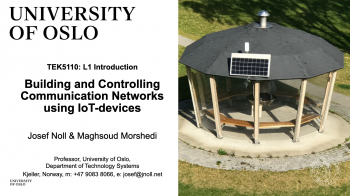Information for "TEK5110"
Basic information
| Display title | TEK5110 - Building and Controlling Communication Networks using IoT-devices |
| Default sort key | TEK5110 |
| Page length (in bytes) | 14,096 |
| Page ID | 10439 |
| Page content language | English (en) |
| Page content model | wikitext |
| Indexing by robots | Allowed |
| Number of views | 227,504 |
| Number of redirects to this page | 1 |
| Counted as a content page | Yes |
Page protection
| Edit | Allow all users |
| Move | Allow all users |
Edit history
| Page creator | Josef.Noll (Talk | contribs) |
| Date of page creation | 08:44, 26 November 2013 |
| Latest editor | Josef.Noll (Talk | contribs) |
| Date of latest edit | 14:18, 21 August 2023 |
| Total number of edits | 241 |
| Total number of distinct authors | 3 |
| Recent number of edits (within past 91 days) | 0 |
| Recent number of distinct authors | 0 |
Page properties
| Transcluded templates (2) | Templates used on this page: |
Facts about "TEK5110"RDF feed
| Abstract | The course provides knowledge on how to bu … The course provides knowledge on how to build networks, based on radio characteristics, mobile and wireless systems, propagation characteristics. Hands-on experiences with radio communications are used to complement the theory. Likewise, a practical introduction to network monitoring and control is given, both from a theoretical point of view, and from a practical implementation.view, and from a practical implementation. + |
| Course Image | + |
| Keywords | Radio +, Antennas +, Propagation +, Bandwidth +, Gain +, Capacity +, Mobile Systems +, Shannon +, Mobility +, MobileIP +, MobileIPv6 +, Remote Management +, Emerging Economies +, GSM +, 3G +, 4G +, 5G +, Network Slicing +, Digital Inclusion +, 6G +, Resillient Energy Networks +, Energy systems +, Smart Energy + and Power tags + |
| Lecturer | Josef Noll + and Maghsoud Morshedi + |
| News | Lectures on Tuesday afternoon, each autumn, first lecture 22Aug2023 + |
| Objective | Objectives to be updated, see info. Th … Objectives to be updated, see info. This course is extending the knowledge of students into the areas of radio communications and should thus be seen as a supplement to high-frequency directional radio links and mobile radio evolutions. Focus in this course will be on radio links for personal and mobile devices covering from some cm (contactless, short range) up to some 10 meters (wireless area). The second half of the course will specific topics in building networks. Topics include: (i), Principles of radio propagation and radio interaction, (ii) Research topics in contactless, short-range and wireless radio networks, (iii) Remote management of wireless networks, and (iv) Evaluation of mobile and wireless communication systems for emerging economies. The main goal of the course is to work with scientific literature and analyse advantages and weaknesses of suggested approaches. Students will be asked to select topics, work through the related literature, perform an analysis of the literature, present the results towards the other students and discuss the advantages and shortcomings.This introductory work is mandatory for the participants, as it forms the basis for a home work, analysing selected topics in dedicated areas. The home work will be a report, and contributes to the final grade. Simulations, e.g. network throughput, business aspects or implementation work is the second topic relevant for the final grade. Participants will learn how to evaluate network, and analyse specific radio interfaces for the purpose.specific radio interfaces for the purpose. + |
| Organisation | ITS + |
| ResearchArea | Security +, Radio technology + and Network technology + |
| Title | Building and Controlling Communication Networks using IoT-devices + |
| Type of course | Master + |
